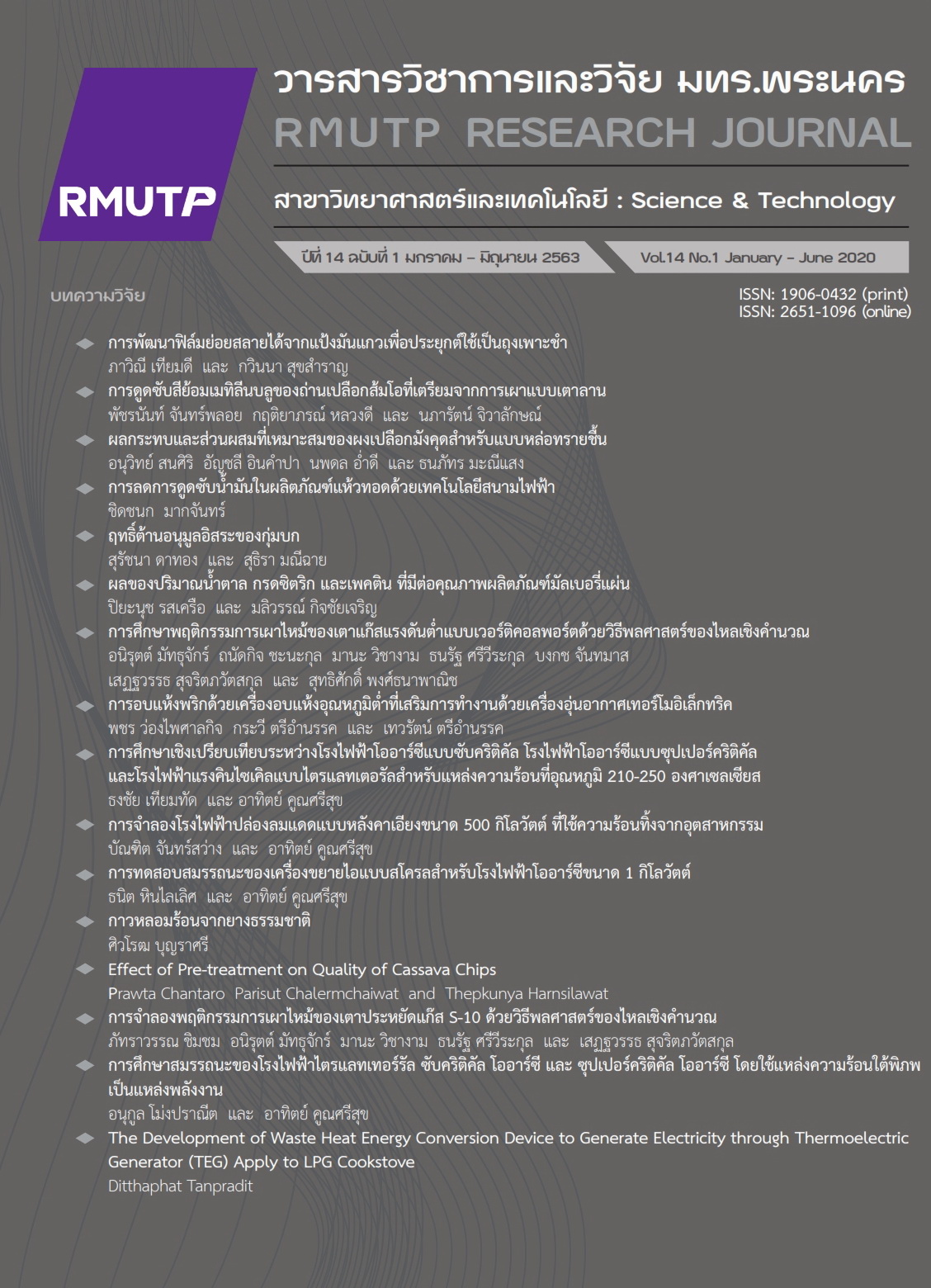ฤทธิ์ต้านอนุมูลอิสระของกุ่มบก
Main Article Content
บทคัดย่อ
งานวิจัยนี้ได้ศึกษาปริมาณสารประกอบฟีนอลิกและฟลาโวนอยด์ และฤทธิ์ต้านอนุมูลอิสระจากกุ่มบก โดยนำใบ ดอก และกิ่งมาสกัดด้วยวิธีการสกัดแบบต่อเนื่องโดยใช้เครื่องสกัดแบบซอห์กเล็ท เป็นเวลา 4 ชั่วโมง ใช้ตัวทำละลาย 3 ชนิด ได้แก่ เอทานอล ไดคลอโรมีเทน และเอทิลอะซิเตต การศึกษาพบว่าใบมีปริมาณสารประกอบฟีนอลิกและฤทธิ์ต้านอนุมูลอิสระสูงสุด ซึ่งใบที่สกัดด้วยเอทานอลมีปริมาณสารประกอบฟีนอลิก (157.13±0.32 มิลลิกรัมสมมูลของกรดแกลลิคต่อกรัมสารสกัดและฤทธิ์ต้านอนุมูลอิสระ DPPH (IC50 1.49±0.02 มิลลิกรัมต่อมิลลิลิตร) ABTS (IC50 0.84±0.01 มิลลิกรัมต่อมิลลิลิตร) สูงสุด ผลของตัวทำละลายพบว่าสารสกัดเอทานอลมีฤทธิ์ต้านอนุมูลอิสระและปริมาณสารประกอบฟีนอลิกสูงสุด สำหรับปริมาณสารประกอบฟลาโวนอยด์ เอทิลอะซิเตตให้ปริมาณสารประกอบฟลาโวนอยด์สูงสุด ซึ่งปริมาณสารประกอบฟีนอลิกจะมีความสัมพันธ์กับฤทธิ์ต้านอนุมูลมูลอิสระอย่างมีนัยสำคัญ ส่วนปริมาณสารประกอบฟลาโวนอยด์ไม่มีความสัมพันธ์กับฤทธิ์ต้านอนุมูลอิสระ
Article Details
เอกสารอ้างอิง
B. N. Ames, M. K. Shigenaga and T. M. Hagen, “Oxidants, antioxidants and the degenerative diseases of aging,” in Proceedings of the National Academy of Sciences of the United States of America, pp. 7915-7922, 2015.
T. Wang, Q. Li and K. Bi, “Bioactive flavonoids in medicinal plants: structure, activity and biological fate,” Asian Journal of Pharmaceutical Sciences, vol. 13, no. 1, pp. 12-23, 2018.
R. Meera and S. Venkataraman, “Characterization and Evaluation of Antioxidant Activity of Crataeva magna Lour (DC),” Journal of Global Pharma Technology, vol. 9, no. 9, pp. 1-7, 2017.
J.Abirami, G.Jothi and P. Brindha, “Microscopic, physicochemical and phytochemical screening of Crateva magna (LOUR) DC. (LEAF),” International Journal of Current Pharmaceutical Research, vol. 9, no. 5, pp. 201-204, 2017.
N. E. Udeh and S. O. Onoja, “Analgesic and free radical scavenging activities of hydromethanolic extract of Crateva adansonii stem bark,” Journal of Intercultural Ethnopharmacology, vol. 4, no. 3, pp. 224-227, 2015.
T.N.Amos, L. Bashir, S. E.Saba, M. A. Saba, B. M. Mohammed, I.H.Abdulsalam and G.J.Josiah, “Phytochemicals and Acute Toxicity Profile of Aqueous and Methanolic Extracts of Crateva adansonii Leaves in Swiss Albino Rats,” Asian Journal of Biochemistry, vol. 10, no. 4, pp. 173-179, 2015.
M. K. Tchimene, C. O. Nwaehujor, M. Ezenwali, C. C. Okoli and M. M. Iwu, “Free Radical Scavenging Activity of Lupeol Isolated from the Methanol Leaf Extract of Crateva adansonii Oliv. (Capparidaceae),” International Journal of Pharmacognosy and Phytochemical Research, vol. 8, no. 3, pp. 419-426, 2016.
C. O. Ajanaku, J. O. Echeme, R. C. Mordi, O. O. Ajani, J. A. O. Olugbuyiro, T. F. Owoeye, O. S. Taiwo and J. U. Ataboh, “Phytochemical Screening and Antimicrobial Studies of Crateva adansonii Leaf Extract,” Covenant Journal of Physicl & Life Sciences (CJPL), vol. 4, no. 2,pp. 35-41, 2016.
S. N. Hade, P. A. Joshi, H. H. Pilley, V. P. Wadegaonkar and P.A.Wadegaonkar, “Evaluation of Crataeva nurvala extracts as antioxidant, antiproteolytic and cytotoxic against hepato-carcinoma and mouse melanoma cell lines,” Journal of Applied Pharmaceutical Science, vol. 6, no. 9, pp. 189-196, 2016.
N. A. Wagay, N. A. Khan and S. P. Rothe, “Profiling of secondary metabolites and antimicrobial activity of Crateva religiosa G. Forst. Bark - A rare medicinal plant of Maharashtra India,” International Journal of Biosciences, vol. 10, no. 5, pp. 343-354, 2017.
S. Dudonne, X.Vitrac, P. Coutiere, M.Woillez and J-M.Merillon, “Comparative study of antioxidant properties and Total phenolic content of 30 plant extract of industrial interest using DPPH, ABTS, FRAP , SOD and ORAC assays,” Journal of agricultural and food chemistry, vol. 57, no. 5, pp. 1768-1774, 2009.
C.Prommuak, W.De-Eknamkul and A.Shotipruk, “Extraction of flavonoids and carotenoids from Thai silk waste and antioxidant activity of extracts,” Separation and Purification Technology, vol. 62, no. 2, pp. 444-448, 2008.
K.Likhitwitayawuid, C.Klongsiriwet, V. Jongbunprasert and B. Sritularak, “Flavones with free radical scavenging activity from Goniothalamus tenuifolius,” Archives of Pharmacal Research, vol. 29, no. 3, pp. 199-202, 2006.
B. Payet, J. Smadja and A. S. C Sing, “Assessment of Antioxidant Activity of Cane Brown Sugars by ABTS and DPPH Radical Scavenging Assays: Determination of Their Polyphenolic and Volatile Constituents,” Journal of Agricultural and Food Chemistry, vol. 53, no. 26, pp. 4-9, 2005.
M. S. Mohsen and S. M. A. Ammar, “Total phenolic contents and antioxidant activity of corn tassel extracts,” Food Chemistry, vol. 112, no. 3, pp. 595-598, 2009.
C. M. Dabire, R. K. Bationo, A. Hema, R. C. H. Nebie, E. Pale, S. P. Dhanabal and M. Nacro, “Total phenolics content, flavonoids profiling and antioxidant activity of Lippia multiflora leaves extracts from Burkina Faso,” Asian Journal of Plant Science and Research, vol. 5, no. 5, pp. 28-33, 2015.
S. Maneechai and P. Rinthong, “Total phenolic and total flavonoid contents, free radical scavenging activity and tyrosinase inhibitory potential from the methanolic extracts of Cajanus cajan (L.) Millsp. And Acacia concinna (Willd.) DC. Flowers,” KKU Science Journal, vol. 44, no. 1, pp. 142-152, 2016.
S. Madla and P. Graidist, “Several Alkaloids Derived from Plants and Their Underlying Molecular Mechanisms of Action in the Fight Against Cancer,” Songklanagarind Medical Journal, vol. 35, no. 1, pp. 83-94, 2017.
S. Rauth, S. Ray, S. Bhattacharyya, D. G. Mehrotra, N. Alam, G. Mondal, P. Nath, B. Roy, J. Biswasa and N. Murmu, “Lupeol evokes anticancer effects in oral squamous cell carcinoma by inhibiting oncogenic EGER pathway,” Molecular and Cellular Biochemistry, vol. 417, no. 1, pp. 97-110, 2016.
P. Daisy, R. Anita and C. Ignatius, “In vitro evaluation of anticancer potentials of lupeol isolated from Elephantopus scaber L. on MCF-7 cell line,” Journal of Advanced Pharmaceutical Technology and Research, vol. 5, no. 4, pp. 179–184, 2014.


